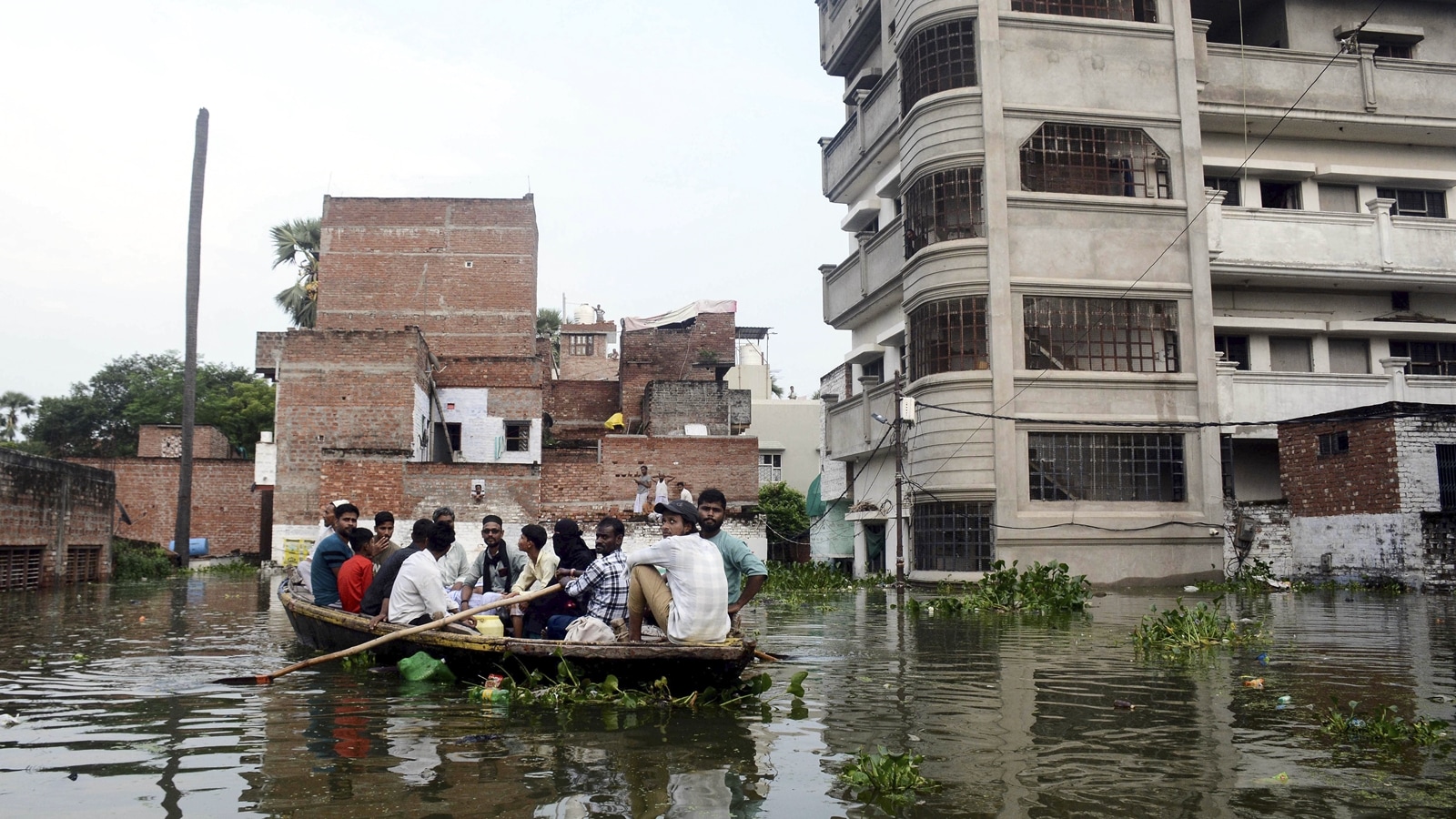‘Entire villages look like islands’: Floods ravage 24 districts in UP
The flood situation in several districts of the eastern part of the state remains extremely critical, especially in rural areas that have been battling rising water levels for nearly a week now.
 Parts of Prayagraj inundated by floodwater from the Ganga and Yamuna, on Wednesday. (PTI)
Parts of Prayagraj inundated by floodwater from the Ganga and Yamuna, on Wednesday. (PTI)As heavy rain continued to lash large parts of Uttar Pradesh for the third consecutive day on Wednesday, the number of flood-affected districts in the state increased to 24, causing serious concern in both rural and urban areas.
The flood situation in several districts of the eastern part of the state remains extremely critical, especially in rural areas that have been battling rising water levels for nearly a week now.
What started as heavy rain has now become a serious crisis as major rivers like the Ganga, Yamuna, and Sharda are flowing above the danger mark in several areas, worrying both locals and officials.
At many places, the rivers have spilled over and flooded nearby villages, farmland, and main roads.
The floodwater has entered hundreds of houses, forcing many families to leave their homes and shift to safer and higher places.
For many, the evacuation was sudden and chaotic as water rose swiftly overnight. They moved through waist-deep water, carrying their children, animals, and important items, and used small boats to reach safer places.
“Villages now look like water-logged islands. Large areas of farmland are underwater, and farmers have lost their crops. Many houses have been damaged, and vehicles parked on the roads have been stuck in floodwater,” said Tej Lal Nishad, a farmer in Lakhimpur Kheri. His wife. Uma Devi, is the pradhan of a village in Phulera block of the district. According to him, the Phulera block has been among the worst affected by the flood, primarily because the Sharda river flows just about 400 metres away from the settlement.

The village, home to nearly 6,000 people, is largely dependent on agriculture, and the rising floodwaters have caused widespread submerged the entire farmlands.
“The river is so close that even a slight rise in water level puts the entire village at risk,” said Nishad.
Nishad said that while immediate relief measures have begun, the villagers are now anxiously waiting for the water to recede so that life can return to normal. “The water level is rising every day, so we urge the government to provide not just temporary relief but long-term solutions, so that we don’t have to face this kind of situation again next year,” he added.
The situation was no different in Ballia district in east UP.
Sumer Yadav, the husband of Chandiya village pradhan Mamta Devi, said: “Due to the flood, we are now relying on boats to move around within the village. Our village got flooded three days ago as water level in the Ghagra and Ganga rivers began to rise significantly.”
“Thankfully, things are still under control and people have not had to leave their homes so far… But with more rainfall expected in the coming days, we are keeping our fingers crossed and hoping the situation does not get worse,” he added.
 People use boats to move from one place to another in the flood-hit areas of Varanasi on Wednesday. (PTI)
People use boats to move from one place to another in the flood-hit areas of Varanasi on Wednesday. (PTI)
Besides Ballia and Lakhimpur Kheri, other districts affected by the flood are Bijnor, Bahraich, Gonda, Banda, Bhadohi, Chandauli, Chitrakoot, Etawah, Farrukhabad, Fatehpur, Ghazipur, Gorakhpur, Hameerpur, Jalaun, Kanpur Dehat, Kanpur Nagar, Kasganj, Mirzapur, Prayagraj, Varanasi, Agra, and Auraiya.
However, since Tuesday, there has been some improvement due to a lull in rainfall. The water level has either started to recede or remained stable without any further rise since Tuesday evening.
Prayagraj city corporator Ranjeev Nishad said that although floodwater is still present, there has been a noticeable improvement over the past two days.
“We have started seeing a gradual decline in the water level, which is a positive sign. However, large parts of the area, including the grounds where the Kumbh Mela was held, remain submerged,” he said.
“The sudden rise in water level a week ago completely changed our daily routine. Many families had to leave their homes or live in extremely difficult conditions,” he said.
Prakash Singh, former pradhan of Sarsol village in Varanasi, said the situation in his village has started to improve gradually as the water level of the Ganga has started to recede. “For the first time in several days, we’re seeing the water slowly going down,” Singh said. “This drop in the water level has brought a sense of hope to the people here. It gives us the feeling that perhaps the worst phase of the flood is over.”
Meanwhile, Flood Relief Commissioner Bhanu Chandra Goswami said the government has provided financial assistance to 360 of the 517 households whose homes were damaged due to the floods.
To prevent the spread of waterborne diseases, 2,04,494 chlorine tablets and 1,60,559 ORS packets have been distributed across vulnerable regions, Goswami said.
Currently, 377 flood shelters are actively housing 41,842 displaced individuals, with 901 medical teams deployed for regular health checkups. In addition, 1,348 flood outposts have been set up for real-time monitoring of the situation, the release added.












